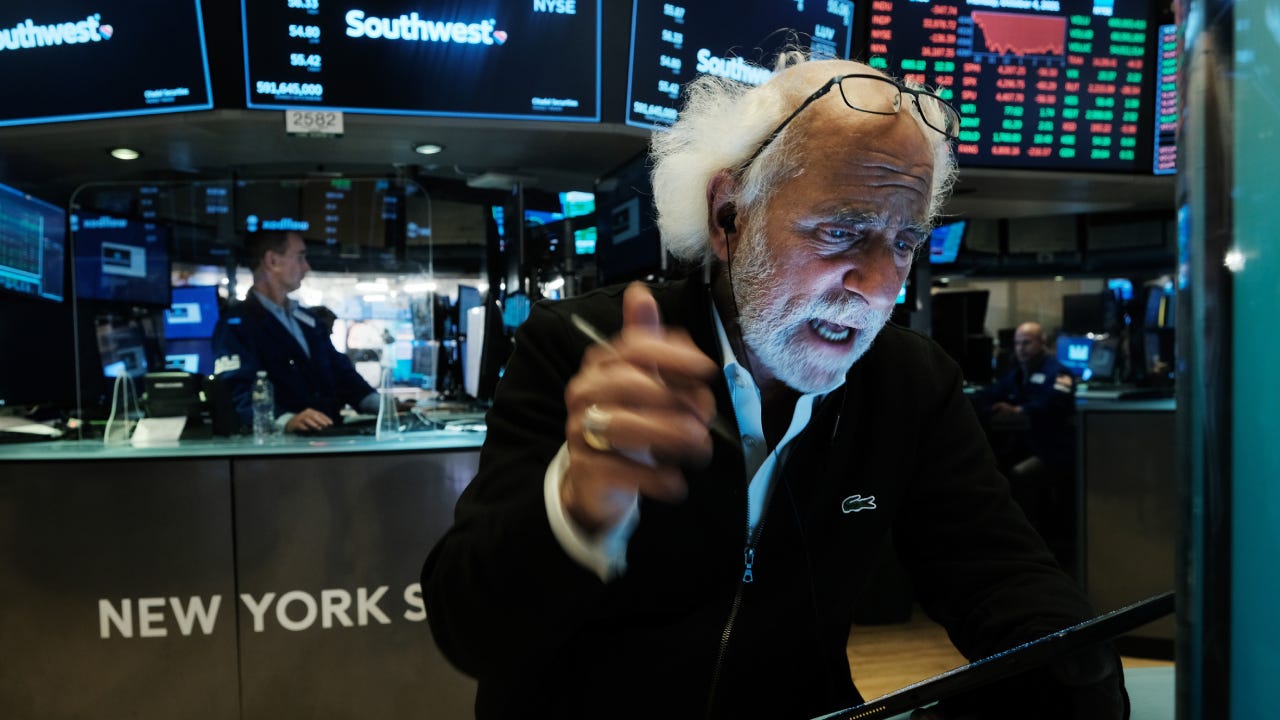2024 stock market outlook: Keep your eyes on interest rates and inflation

The Bankrate promise
At Bankrate we strive to help you make smarter financial decisions. While we adhere to strict , this post may contain references to products from our partners. Here's an explanation for .
Last year the stock market flummoxed those analysts expecting a recession due to the Federal Reserve’s unprecedentedly quick raise of interest rates. Stocks turned in a banner year on the back of strong performances from big tech, and then turned on the afterburners in the last three months to cap it all off. Even financials rallied after a blow-up in the first half. But with stocks now near 52-week highs, how will equities fare in 2024 with looming economic uncertainty?
Experts surveyed in Bankrate’s Fourth-Quarter Market Mavens survey saw the market moving modestly higher in 2024, about 6 percent, amid economic and political uncertainty. Chief among their concerns was interest rates, particularly given stocks’ stupendous performance of late and a market that seems to expect the Fed to lower rates faster than it has indicated it would.
So the Fed’s actions should likely be absolutely central to the market’s performance in 2024.
“As the Fed starts cutting rates this year, that old adage ‘don’t fight the Fed’ almost always bears out,” says Russell Hackmann, CFA, president of Hackmann Wealth Partners. “On the other hand, there are significant factors which may cause ongoing volatility: election year politics, record Federal borrowing pushing up long-term interest rates and geopolitical concerns.”
While many analysts think the market could well climb in 2024, they’re not fully discounting the possibility of a downturn either. As with the start of 2023, market watchers remain divided on the state of the market in the year ahead, as so many variables work to confound predictions.
Keep watching the Fed
The Fed is such a key watchpoint for investors in 2024 because the market seems to expect significant rate cuts this year. While the Fed has said it anticipates cutting rates three times this year, the market is expecting six or seven rate cuts, a divergence that has left many wondering who’s right and what will happen if reality doesn’t conform with the market’s lofty expectations.
“The richly priced market could continue to move higher if the Fed cuts interest rates six times as expected by the market while inflation continues its descent lower,” says Stash Graham, managing director, Graham Capital Wealth Management. But Graham is skeptical.
“If anything, the recent complacency and bullishness of the market at year’s end has only increased the odds of a recession,” he says. “I can’t imagine the Fed loved seeing unprofitable, highly speculative fintech companies appreciating 100 percent plus in the last 60 days of the year.”
Such speculative stocks could falter if rates don’t move as expected. But even well-established leaders may feel some of investors’ disdain if the Fed is not so accommodating. The so-called Magnificent 7 stocks – including Microsoft, Apple and NVIDIA – led the market higher for much of 2023 in a somewhat “narrow” rally. Only late in the year did small- and mid-caps pick up.
The Fed’s key watch point – inflation – has subsided in recent months, and at least by some measures it sits at or below the two percent target reiterated by the Fed. Some deterioration in the economy’s fundamentals may also mean the Fed lowers rates sooner than later.
“The market indices are all up considerably from the lows in October 2023,” says Hackmann. “Much of this rally has been driven by rate-cut expectations. Personally, I think the markets have overshot in terms of the speed of rate cuts. Chairman Powell is going to be quite sure this fight is over before lowering rates considerably. His legacy is on the line.”
Inflation remains a key factor on the direction of rates
With stocks up significantly in 2023, the potential of “higher for longer” interest rates and an economy that could still weaken, the bias might be for a stagnant or lower market in 2024. But a significant economic downturn or intransigent inflation may well still play havoc with the market.
The bellwether 10-year Treasury bond sits well below the 5 percent level it hit in 2023, as investors began pricing in lower short-term rates. A lower 10-year yield also takes some of the pressure off inflation, somewhat dampening the Fed’s actions to slow spiraling prices. For example, the 10-year is key to the mortgage market, with lower rates helping to stoke demand.
Some analysts worry that housing inflation, which carries significant weight in inflation indexes, may prevent inflation from falling further during late summer.
“If inflation levels show signs of life in two quarters, then the Fed might have to stop rate cuts and raise them,” says Graham. “This rapid change in monetary policy could be the worst-case scenario for long-duration assets like stocks.”
So any uptick in inflation could mean that the advent of lower rates is pushed back even further – with potentially serious consequences for stocks.
If Fed rate cuts don’t materialize due to ‘sticky’ inflation and/or continued strength in the labor market, I believe there’s downside to the equity markets, but especially the bond market,” says James Sahagian, CFP, managing director of Ramapo Wealth Advisors at Steward Partners. “I don’t expect this to occur, as several leading market indicators point towards continued declines in inflation and economic growth.”
Weak consumer spending may also lead to a pullback
Consumer spending – which powers some 70 percent of the U.S. economy – also remains a key point. If that begins to crumble, then the economy and stock market may fall quickly.
“The enormous government stimulus and dramatic increase to the money supply during the pandemic along with a strong job market have kept the consumer strong over the past couple years, but early signs of weakness in the economy and job market could lead to a quicker-than-anticipated pullback in spending, leading to a recession,” says Sahagian.
Where can investors see attractive performance in 2024?
The Magnificent 7 stocks surged on the prospects of artificial intelligence leading to a boost in productivity and profits, leading to a run-up in the S&P 500 and the Nasdaq in 2023. Investors may now be wondering where they should turn in 2024 for attractive risk-adjusted returns.
“The artificial intelligence rally associated with the Magnificent 7 needs to take a breather,” says Graham. “There will be positive developments for all of these companies in the long term, but the market has awarded too much too soon.”
Hackmann shares a similar sentiment: “Valuations are fairly stretched in the ‘Magnificent 7’ and other technology stocks and, like most innovations, the practical benefits of AI are likely to become clear only over a longer time period.”
Key alternatives to the large tech names may be stocks that only more recently began to participate in the rally: namely, small- and mid-cap stocks.
“Small- and mid-caps look very cheap relative to their large-cap peers, based on historical averages,” says Sahagian. “They have begun to outperform since the beginning of November 2023.”
“If the market does rally, the unloved stock classifications should play catch up with the Magnificent 7,” says Graham.
Graham also likes overlooked “capital-scarce sectors” that “tend to have strong balance sheets because their access to capital markets is limited.” He points to companies in industries such as tobacco, transportation infrastructure, home builders and energy equipment and services.
“Homebuilders might be a little rich now, but after a decade of underinvestment, the tailwinds over the longer term are strong,” he says.
And with short-term interest rates poised to fall below long-term rates, this “disinversion” of the yield curve could prove beneficial for banks and financials, says Hackmann.
For example, already-profitable banks should be able to turn lower short-term rates into lower deposit rates, trimming one of their most important costs.
Meanwhile, Sahagian says to look for value in traditionally defensive areas such as healthcare, consumer staples and utilities – industries that tend to perform even in tough economies.
How should investors navigate a volatile 2024?
While it may feel like the stock market’s rise in 2023 makes it safer to invest today, long-term investors see increasing prices as heightening the risk in their portfolios. And with not only higher prices than a year ago but still plenty of risks on the horizon, investors need to make smart decisions rather than just ride last year’s market momentum into 2024.
Invest long term
While even long-term investors are watching what happens in the market today, they may not always be investing as if the next leg in the market is down (or up). Instead, they’re thinking the odds are good that the market is much higher in five or ten years than it is today. Then they invest with that mindset and don’t worry too much where stocks go this month or year.
This long-term attitude turns a decline in the market into an opportunity to invest at lower prices, creating a lower-risk investment. Long-term investors may approach investing using dollar-cost averaging, adding money to the market regularly regardless of what’s happening. This strategy helps investors keep their emotions out of the process and stay focused on the long term, too.
Remain disciplined
It can be difficult when the market runs higher, as it did in 2023, not to chase it. It may seem like everyone else is making money, while your portfolio is only inching up or even falling. At times like these, it’s vital to keep your investing discipline, and not chase the market emotionally.
If your approach is to invest money regularly in the market, then stick with that. If your process is to seek out undervalued individual stocks and only buy when you’ve found an attractive prospect, then continue on with that. Stick with the approach that works for you.
Stay invested
For long-term investors, it can be tough to stay invested, especially if the market looks set to turn lower. But investors who bailed out at the end of 2022 after an abysmal year may regret making that decision after stocks rallied fiercely for most of last year and closed much higher.
That’s why it’s so critical to stay invested and not trade in and out of the market. Unless you do, you won’t get a fund’s long-term return. In the case of S&P 500 funds, that’s about 10 percent annually on average. Study after study shows that passive investing beats active investing.
The importance of staying invested is also why you must avoid things that may force you out of the market. For example, you want to have an emergency fund so you don’t have to tap your investments just when they’re down, prohibiting you from enjoying their subsequent rebound. It’s also why you don’t invest money that you can’t keep invested for at least three to five years.
Bottom line
In times of potential volatility such as 2024, investors should stick primarily with their long-term game plan, even if they’re adding a bit more to short-term positions at the margins. Such a long-term approach means remaining disciplined in good times and bad, because it can often be difficult to determine whether it was good or bad time until the market moves definitively.
Related Articles



